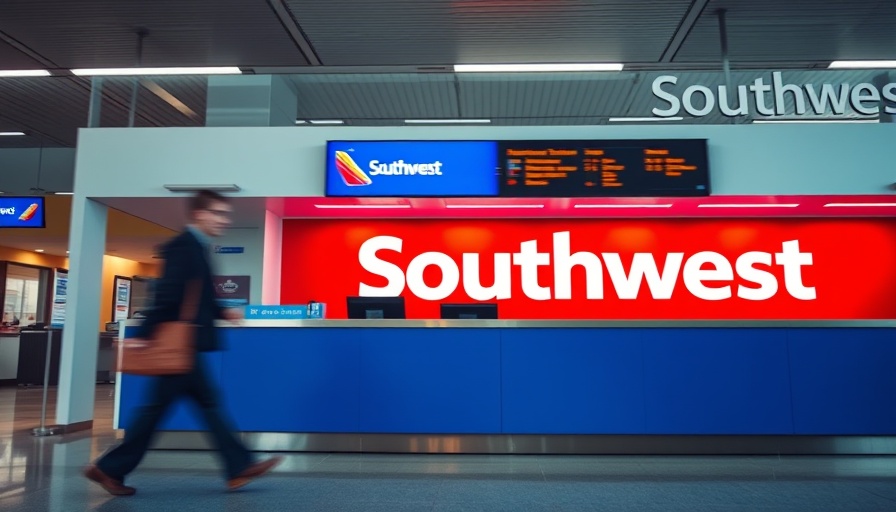
A Sudden Descent: A Flight's Near Miss in the Skies
On a seemingly routine flight from Hollywood Burbank Airport to Las Vegas, passengers aboard Southwest flight 1496 experienced a shocking incident shortly after takeoff. Just minutes into the flight, the aircraft took a sudden dive in response to an alert regarding a nearby aircraft, reflecting just how crucial airspace safety remains in our increasingly crowded skies.
The Incident Details: A Closer Look
The flight was involved in what is being referred to as a 'near miss' situation, prompting the pilot to perform a maneuver that injured two flight attendants. The Federal Aviation Administration (FAA) has since initiated an investigation to unravel the specifics of the incident. Initially departing shortly before noon, passengers reported feeling a sudden drop that made headlines and sparked concerns among travelers worldwide.
Passengers instantly took to social media, some sharing their thoughts and reactions. Prominent comedian Jimmy Dore reported on X, expressing shock that the plane’s collision warning system had gone off, necessitating an emergency maneuver to avoid potential disaster. This showcases not only the pressures pilots face in real-time situations but also illustrates the rapid spread of news in the digital age.
The Investigation: What’s Next?
As the investigation unfolds, it raises important questions about aviation safety standards and protocols, particularly following a tragic midair collision earlier this year that tragically resulted in 67 fatalities. With many families and travelers relying on commercial airlines for their journeys, incidents such as this understandably stir deep concern regarding public safety in the aviation sector.
To maintain public trust, it's imperative that airlines and regulatory bodies like the FAA take visible actions and ensure adherence to rigorous safety measures. The outcomes of such inquiries are vital not only for informing passengers but also for driving improvements within the industry.
The Role of Safety Protocols in Aviation
Throughout aviation's history, safety has always been paramount, and this incident reiterates the vital need for airlines to continuously update and reinforce safety protocols. Mechanical and procedural advancements are essential in ensuring such situations are addressed swiftly and efficiently. Enhanced training for crew members on how to manage emergencies can also mitigate risks during critical situations.
Moreover, the implementation of reliable technologies that assist pilots in collision avoidance can significantly reduce the incidence of close calls, protecting the lives of all those onboard.
Historical Context: Aviation Safety Trends
In the broader landscape of aviation history, incidents like this draw parallels to previous safety concerns. The years following major accidents have historically seen increased scrutiny on regulations and operator behaviors, often leading to significant upgrades in technology and training procedures within airlines. Notably, the aviation industry has seen a steady decline in fatal accidents owing to such improvements.
As aviation technology advances, including more robust monitoring systems and advanced real-time data analytics, the potential for reducing safety risks grows exponentially. Future predictions suggest a trend toward even more automated systems that can detect and rectify possible collisions long before they occur.
What This Means for Travelers: Understanding the Impacts
For travelers and families, understanding aviation safety news is not just about staying informed; it's about empowering oneself with knowledge that can enhance decision-making when it comes to flight choices. As airlines continue to face scrutiny, consumers must remain vigilant regarding the safety records of carriers and the protocols they have in place.
Public transparency from airlines during these stressful situations can help alleviate fears while educating passengers on what safety measures are being taken in response to incidents like the near miss experienced by Southwest flight 1496.
Conclusion: The Import of Public Safety in Aviation
The recent events surrounding Southwest flight 1496 highlight the persistent challenges airlines face concerning safety and public trust. As investigations continue and lessons are learned, it is crucial for travelers to remain informed, ensuring their journey is safe and secure. Rest assured, the aviation community is working diligently to ensure each flight is managed with the utmost care and responsibility.
In moments of uncertainty like these, knowledge and vigilance become essential tools for families and travelers, allowing them to better navigate the skies.
 Add Row
Add Row  Add
Add 




Write A Comment